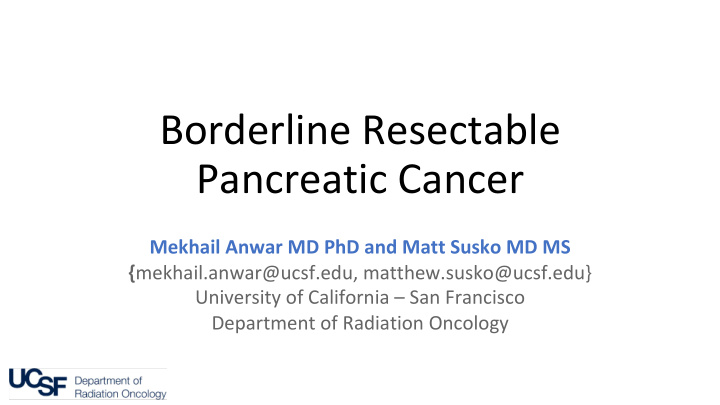



Borderline Resectable Pancreatic Cancer Mekhail Anwar MD PhD and Matt Susko MD MS { mekhail.anwar@ucsf.edu, matthew.susko@ucsf.edu} University of California – San Francisco Department of Radiation Oncology
Case Presentation 63 y/o male with painless jaundice, intermittent epigastric pain and 25 lbs weight loss over 6 months. Exam : Thin slightly jaundiced male. Labs: AST/ALT – 65/83 ALKP - 320 Tbili – 7.5 CA 19-9 - 276 CEA - 1.7 Imaging Workup: EUS/biopsy – Pancreatic Adenocarcinoma PET/CT – No distant metastatic disease Pancreatic Protocol CT …
Initial Diagnostic CT Imaging Borderline Resectable Solid tumor contact with 1. CHA without extension to CA or hepatic artery bifurcation 2. SMA ≤180° 3. CA ≤180° 4. SMV or PV of >180°, contact of ≤180° with contour irregularity of the vein • Mass in the pancreatic head and uncinate process with 5. Inferior vena cava (IVC) associated pancreatic and intrahepatic ductal dilation • The mass partially surrounds the proximal portal vein, abuts the celiac artery and SMA and left renal vein
Synergistic Strategies 1. Surgery: Local, Curative Survival 2. Local (RT) 3. Systemic Local (+Systemic?) Systemic + Local
Surgery: Striving for an R0 Resection R0 R0 Chang et al. JCO 2009 Detmir et al. Ann. Surg 2017 How can we maximize opportunity for R0 resection?
Question: Initial Management In this borderline resectable pancreatic cancer patient, what would your preferred course of management be? A. Chemotherapy alone; no role for local therapy. B. Chemoradiation followed by surgery. C. Chemotherapy followed by surgery D. Chemotherapy, chemoradiation/SBRT, followed by surgery. E. Surgery followed by chemoradiation and/or chemotherapy.
Chemoradiation Upfront PREOPANC-1 Results • Arm A: Surgery → CRT → CTx Arm A Arm B • Arm B: CRT → Surgery → CTx N 127 119 • CRT OS 13.5 mo 17.1 mo • 36 Gy (2.4 Gy x 15 fx) Resected 72% 62% • Weekly gemcitabine • 246 patients % R0 31 65 LRFI 11.8 mo NR OS (resected) 16.8 mo 42.1 mo
Chemotherapy Identifies patients likely to development metastases or progress in short interval 1 30-40% of patients progress within 3-4 months when treated with - chemotherapy alone Is neoadjuvant chemotherapy sufficient? 2 Retrospective review of FOLFIRINOX with or without RT - 26 patients, 22 treated with chemotherapy alone - 90% R0 resection rate with FOLFIRINOX alone, addition of CRT led to 100% - Evans grade III-IV specimens Hammel et al. JAMA 2016. (LAP 07) Kim et al. J Surg Onc 2016
Combination therapy: Neoadjuvant CTx + RT FOLFIRINOX + Chemoradiation 1 • • 15/22 underwent resection, 14/15 were R0 resections • 5 patients with <5% residual tumor and 2 with complete pathologic response Chemotherapy with adaptive radiation therapy 2 • 48 patients with 8 cycles neoadjuvant FOLFIRINOX, RT based on evidence of • persistent vessel involvement • If involvement à CRT • If no involvement à hypofractionated RT 32/48 underwent resection, 31/32 were R0 resections • Key Questions • Alliance Trial – CRT vs SBRT? • Response Assessment - Optimizing imaging strategies • 1. Katz et al. JAMA Surgery 2016 2. Murphy et al. JAMA Oncology 2018
Response to Neoadjuvant FOLFIRINOX Completed 12 cycles of FOLFIRNIOX • Labs: Normalized • • AST/ALT – 35/42 ALKP – 80 Tbili – 1.6 CA 19-9 - 32 CEA - 1.6 Re-staging Imaging • • Slight interval decrease in size of primary pancreatic mass and retroperitoneal and peripancreatic lymphadenopathy. No contact with SMA or Celiac •
Role of Radiation Therapy In this case of a patient with borderline pancreatic cancer, with a durable response to chemotherapy, what is the role of radiation therapy? A. There is no role for radiation therapy. Proceed to surgical evaluation. B. SBRT, then surgery. C. Chemoradiation, then surgery. How does this change if there is persistent vascular involvement?
Comments and Discussion
Chemoradiaton Korean Study (MA)
Recommend
More recommend